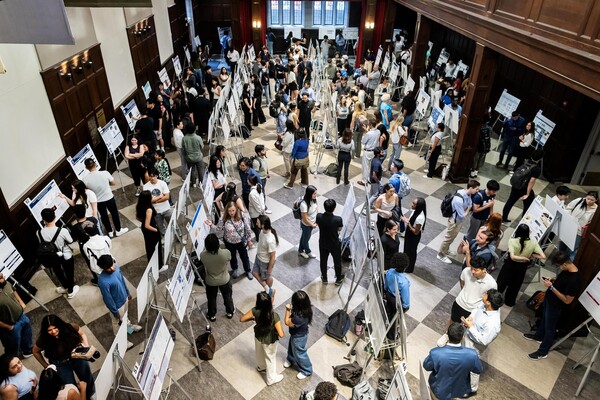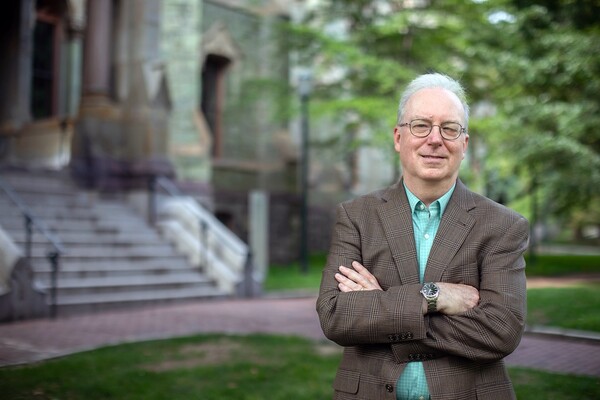
Image: Mininyx Doodle via Getty Images
From South Florida to South Texas, one of the narratives emerging from Election Night 2020 was how Latinos around the country voted. President Donald Trump’s campaign made inroads with Latino voters despite his anti-immigrant rhetoric and policies, but at the same time grassroots efforts helped turn Arizona and Nevada blue. But is Trump’s success surprising? And why does the notion of Latinos as a monolithic bloc that tends to vote one way persist despite its actual heterogeneity?
Political scientist Michael Jones-Correa has studied Latino voters for years, and his new book, “Holding Fast: Resilience and Civic Engagement Among Latino Immigrants,” looks at how Trump’s rhetoric and policies impacted Latino immigrants’ civic involvement.
No one should be surprised by the way Latinos voted this year, he says.
“Ever since the 1960s, Latinos have broken about two to one for Democrats versus Republicans, and this election cycle is not any different,” he says, noting about 66% of Latinos voted for President-elect Joseph Biden.
Although the shift to the GOP in South Texas was a surprise to many, Jones-Correa says the Democratic Party hasn’t invested in the area, so voters there were open to an appeal by Republicans on economic arguments, particularly because many residents work for federal agencies on the border.
“There are lots of reasons why you might see this kind of shift, but the underlying story really is one of neglect, and it’s one that you also see played out in South Florida,” he says.
The success story of Arizona was not because of attention and investment from the Democratic Party but was instead due to local grassroots organizations building over the previous decade in response to Arizona’s own anti-immigrant state laws and anti-immigrant former sheriff of Maricopa County, he says.
This is a problem with political parties in the United States in general, which mobilize episodically every four years, says Jones-Correa, but the pandemic made even that episodic outreach more challenging. Campaigning slowed, and it took the Biden campaign longer to raise money. Traditional in-person voter outreach wasn’t as strong due to social distancing efforts by Democrats in particular. The GOP, on the other hand, was very active conducting in-person outreach in South Florida and had a robust Spanish-language infrastructure there, unlike Democrats.
“One lesson from this election is you can’t take things for granted. It should have been the lesson Democrats learned in 2016,” he says. “This is a very closely divided country, with substantial demographic changes underway. A lot of things that we assume are fixed in place are not.”
The American tendency by both the government and the media to lump Latinos together because of language commonality leads to misunderstanding the diverse group, he says.
The way the U.S. perceives ethnicity is racialized, says Jones-Correa, because “everything is defined against the Black/white divide.
“We have in the United States a conception of race that builds on the ‘one drop rule’ that even if you’re a little bit African American, that makes you Black, and if you don’t have anything African American, then by definition, you’re something else,” he says. “This tends to shape how we see every ethnicity and race, and so it shapes how we think about Latinos and Hispanics in the United States.”
This lumping together also happens with whites, Asian Americans, and African Americans, he says.
Historian Ann Farnsworth-Alvear spent the weeks leading up to the election working on a Spanish-language hotline answering questions from voters in Philadelphia, as well as creating and distributing Spanish-language materials about early voting sites in Philadelphia.
Her election work focused on areas of North Philadelphia seen as primarily Puerto Rican, but even in that small slice of Philadelphia there’s a lot of diversity: Colombians, Mexicans, Costa Ricans, Haitians, and Ecuadorans.
“You can take that national insight about heterogeneity all the way down to the ward and division level here,” she says. She found that Trump’s targeting of immigrants and his language about immigrants galvanized activists to work hard on ‘get out the vote’ efforts despite the pandemic.
“There was so much work that had to be done with the complexity of early voting sites, and that work was done largely by volunteers who were very committed to ensuring access to the process of voting,” she says.
As a historian of modern Latin America, Farnsworth-Alvear sees the persistence of the idea of a single “Latino” voter as part of the obsession in the U.S. of labeling people and groups, born out of the history of segregation.
The level of surprise some had for the election results in South Texas and South Florida speaks to an overall lack of understanding Latinos in the U.S., she says.
“It asks Americans in the United States in general to look in the mirror and begin to think about how they perceive Latin Americans. How do they perceive mixed-status families? How do they perceive children of immigrants, and what kind of assumptions are impeding a national conversation about why there is this level of misunderstanding?” says Farnsworth-Alvear.
The short answer is racism and ethnocentrism, she says, but it also is rooted in a century of U.S. imperialism in Latin America.
“This is a very long history, not only of misunderstanding but of power dynamics in the hemisphere that are felt at the level of neighborhoods and interpersonal conversation,” she says.
Demographer Emilio Parrado says understanding the Latino vote is crucial, particularly for the Democratic Party because it could provide a basis for understanding what could produce a different majority.
“This election was a warning sign that the Democratic Party can’t take any minority group for granted,” he says.
It’s not just about Latinos. The same lack of understanding is happening with Asian Americans and even at some level African Americans and African immigrants, says Parrado, whose research looks at the Hispanic population of the United States, especially issues of immigrant adaptation and new areas of migrant settlement.
There needs to be careful analysis about what motivates people to vote, breaking racial and ethnic divisions and instead looking at issues of age, gender, and cultural diversity, he says.
“Latinos exemplify what could be a momentous change in how we think about producing a new majority in the U.S. that’s not going to be just along racial and ethnic lines,” he says. “You can’t just go with labels. You have to pay attention to the issues that these groups face.”
Going forward, both parties will be paying increased attention to Latino voters because each year there are at least 800,000 new potential Latino voters, Jones-Correa says. Half a million Latino youth turn 18 each year, and 300,000 naturalize as U.S. citizens annually.
The fact that many eligible Latino voters are new voters means that they may have shallow partisan attachments and are open to appeals from either party, shedding the myth that Latino voters are a sure thing for Democrats. On the grounds of family values, religion and military service, some Latino voters will be attracted to the appeals of the Republican Party.
“‘One size fits all’ appeals will not work for Latino voters,” says Jones-Correa. “This is an electorate that varies significantly by nationality, state of residence, gender, age, and religion.”
Parrado notes that Bernie Sanders was making a lot of progress among Latinos in talking about issues of inequality, class, and labor protections, some of the talking points that got picked up by Trump in terms of a populist message, he says.
“In many ways this election was a struggle between cultural visions, and Latinos fit into that story,” says Parrado. “Understanding the Latino vote is crucial for understanding where the U.S. is heading. Latinos are not clearly defined. We all come from different places, we all have different histories, and we bring that diversity to the group. Understanding that diversity is the challenge.”
Michael Jones-Correa is a President’s Distinguished Professor of Political Science in the Political Science Department in the School of Arts & Sciences and director of the Center for the Study of Ethnicity, Race, and Immigration at the University of Pennsylvania.
Ann Farnsworth-Alvear is an associate professor of history in the Department of History and undergraduate advisor for Latin American and Latino Studies in the School of Arts & Sciences at Penn.
Emilio Parrado is the Dorothy Swaine Thomas Professor of Sociology in the Department of Sociology in the School of Arts & Sciences and director of the Population Studies Center at Penn.
Kristen de Groot

Image: Mininyx Doodle via Getty Images

nocred

Image: Pencho Chukov via Getty Images

Charles Kane, Christopher H. Browne Distinguished Professor of Physics at Penn’s School of Arts & Sciences.
(Image: Brooke Sietinsons)